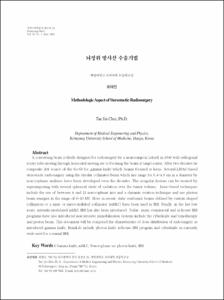뇌정위 방사선 수술기법
- Keimyung Author(s)
- Choi, Tae Jin
- Journal Title
- Keimyung Medical Journal
- Issued Date
- 2012
- Volume
- 31
- Issue
- 1
- Keyword
- Gamma knife; MMLC; Non-coplanar arc photon knife
- Abstract
- A conversing beam is firstly designed for radiosurgery by a neurosurgeon Leksell in 1949 with orthogonal x-rays tube moving through horizontal moving arc to focusing the beam at target center. After two decades he composits 201 source of the Co-60 for gamma knife which beams focused at locus. Several LINAC-based stereotactic radiosurgery using the circular collimated beam which size range for 0.4~4.0 cm in a diameter by non-coplanar multiarc have been developed over the decades. The irregular lesions can be treated by superimposing with several spherical shots of radiation over the tumor volume. Linac-based techniques include the use of between 4 and 11 non-coplanar arcs and a dynamic rotation technique and use photon beam energies in the range of 6~10 MV. More in recent, static conformal beams defined by custom shaped collimators or a mini- or micro-multileaf collimator (mMLC) have been used in SRS. Finally, in the last few years, intensity-modulated mMLC SRS has also been introduced. Today, many commercial and in-house SRS programs have also introduced non-invasive immobilization systems include the cyberknife and tomotherapy and proton beam. This document will be compared the characteristics of dose distribution of radiosurgery as introduced gamma knife, BrainLab include photon knife in-house SRS program and cyberknife in currently wide used for a cranial SRS.
- Alternative Title
- Methodologic Aspect of Stereotactic Radiosurgery
- Keimyung Author(s)(Kor)
- 최태진
- Publisher
- Keimyung University School of Medicine
- Citation
- 최태진. (2012). 뇌정위 방사선 수술기법. Keimyung Medical Journal, 31(1), 1–16.
- Type
- Article
- Appears in Collections:
- 2. Keimyung Medical Journal (계명의대 학술지) > 2012
1. School of Medicine (의과대학) > Dept. of Medical Biophysics Engineering (의공학과)
- 파일 목록
-
-
Download
 뇌정위 방사선 수술기법.pdf
기타 데이터 / 1.39 MB / Adobe PDF
뇌정위 방사선 수술기법.pdf
기타 데이터 / 1.39 MB / Adobe PDF
-
Items in Repository are protected by copyright, with all rights reserved, unless otherwise indicated.